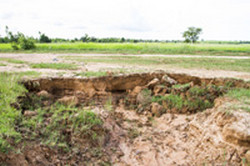Effect of erosion on soil carbon
The advent of intensive agriculture in the second half of the 20th century significantly increased soil erosion. One consequence was changes to the distribution of SOC, especially within croplands under conventional tillage. Although attempts have been made to map SOC at national scale based on land use, soil type and climate, detailed predictions of SOC were lacking. The EU-funded D3DC project addressed this situation, studying SOC at smaller scales in complex terrains and influenced by water and tillage erosion. The project aimed to improve understanding of the vertical and horizontal movement of SOC caused by erosion, as well as its stability. This was achieved by coupling soil respiration experiments at depth with empirical and process-based spatial models. Project partners studied the variation in quantity and quality of SOC depth distribution along typical hillside transects under cropland in Devon, United Kingdom. The results were related to soil redistribution rates and variations in carbon input (below- and above-ground biomass productivity). Measurements of carbon dioxide (CO2) production in long-term incubation experiments were used to study stability of organic matter at different depths in soil profiles from both eroded and depositional areas. Results showed contrasting vertical patterns in SOC stock and stability depending on the rate and type of erosion. Results from D3DC will help to improve long-term soil fertility and carbon storage management in eroding landscapes. This is an important step in the evolution of 3D spatial models of SOC dynamics and their implementation in land surface exchange schemes of Earth System models. Researchers also predicted how the distribution of SOC in France will evolve as a result of climate and land-use changes until the year 2100. This will enable scientists to identify those regions most likely to experience a significant gain or loss of SOC. It will also reveal the extent to which land-use decisions and outcomes control the scale of SOC gain or loss. The methodology developed by D3DC and the resulting maps will act as powerful tools for supporting decision making regarding appropriate soil management. This may involve increased SOC storage, thereby reducing soil-related CO2.




